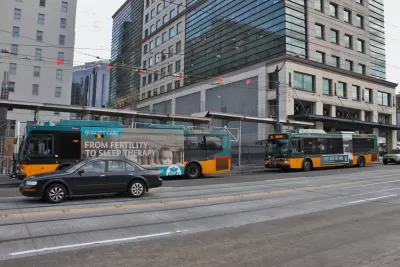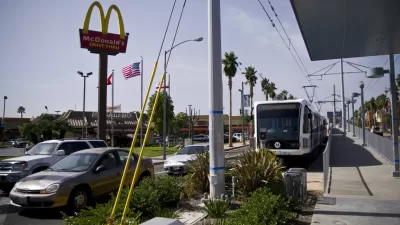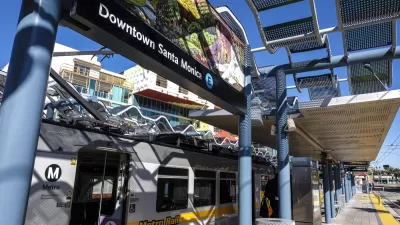One common explanation for recent declines in transit ridership is that gentrification has driven lower-income commuters into car-dependent suburbs. But does data bear this out?

While reading articles and blog posts (including my own) on transit ridership, one idea that I have seen raised here and there is that gentrification is a major culprit: as cities have become more attractive to well-off commuters, lower-income commuters have been priced out of cities and moved to suburbs where they are more likely to need cars to reach jobs and other destinations.
How might this hypothesis be tested? It seems to me that if gentrification reduced transit ridership, the most expensive, rapidly gentrifying cities would have experienced the greatest losses in transit ridership, while inexpensive, declining cities would have relatively robust ridership.
I tested the hypothesis by examining two sets of cities: a group of expensive cities and a group of declining cheap cities. My "expensive city" group includes Portland, Seattle, San Francisco, Washington, New York, and Boston.* If the gentrification hypothesis were correct, these cities' transit systems would be in deep trouble: these cities have experienced a period of midcentury decline, growth in the past decade or two or three, and a significant rise in housing costs. Over the past year (from the first three quarters of 2016 to the first three quarters of 2017), all but one of these cities (Seattle)** have experienced roughly the same decline in transit ridership, between 2 and 4 percent. (Data available here.)
My "cheap city" group is comprised of low-cost, declining Rust Belt cities, including Buffalo, Detroit, St. Louis, Cincinnati, Cleveland, Milwaukee, and Baltimore. If gentrification was a significant cause of declining ridership, these cities' transit systems would be stable. But in fact, these cities' transit systems are in far worse shape than those of the growing cities. Over the past year, Detroit's ridership declined by more than 10 percent (from about 22 million rides to about 19 million) and the other cities' ridership declined by somewhere between 4.5 percent (Cincinnati) and 7.9 percent (Cleveland).
Of course, data from one year may not establish a long-term pattern. How have these cities' transit systems performed since the bottom of the recession in 2009? Costly cities have achieved very mixed results: Washington's ridership has declined due to a variety of disasters arising from deferred maintenance. But in Boston, Seattle, New York, and San Francisco, transit ridership was actually higher in 2016 than it was in 2009. (Portland's ridership was almost identical: 100.1 million in 2009, 100 million in 2016.) So the first half of the 2010s was actually pretty good for transit systems in gentrifying cities.
How does the Rust Belt compare? Between 2009 and 2016, ridership declined in Detroit, St. Louis, Cincinnati, Cleveland, Milwaukee, and Baltimore, rising only in Buffalo. And in all of these cities but Baltimore, ridership declined by over 10 percent. Thus, it appears that urban decay is far worse than gentrification for transit ridership; as people moved out of the city, they stopped using transit.
I note that these comparisons exclude two groups of major cities: "in between cities" that aren't very expensive but have experienced modest gentrification (such as Chicago, Minneapolis and Philadelphia) and "elastic cities" that never experienced citywide decline (such as Dallas, Houston, Phoenix, and Austin). I am not sure that the data show any strong pattern as to these cities: for example, ridership rose modestly in Minneapolis, Dallas, and Houston between 2009 and 2016, but declined in Chicago, Austin, and Philadelphia.
*This sample does exclude some very expensive cities that never experienced citywide decline, most notably Los Angeles and San Diego. Transit ridership has consistently declined in Los Angeles in recent years, but has risen in San Diego since 2009.
**Seattle is an exception to the national trend of declining transit ridership.

Alabama: Trump Terminates Settlements for Black Communities Harmed By Raw Sewage
Trump deemed the landmark civil rights agreement “illegal DEI and environmental justice policy.”

Study: Maui’s Plan to Convert Vacation Rentals to Long-Term Housing Could Cause Nearly $1 Billion Economic Loss
The plan would reduce visitor accommodation by 25% resulting in 1,900 jobs lost.

Planetizen Federal Action Tracker
A weekly monitor of how Trump’s orders and actions are impacting planners and planning in America.

Wind Energy on the Rise Despite Federal Policy Reversal
The Trump administration is revoking federal support for renewable energy, but demand for new projects continues unabated.

Passengers Flock to Caltrain After Electrification
The new electric trains are running faster and more reliably, leading to strong ridership growth on the Bay Area rail system.

Texas Churches Rally Behind ‘Yes in God’s Back Yard’ Legislation
Religious leaders want the state to reduce zoning regulations to streamline leasing church-owned land to housing developers.
Urban Design for Planners 1: Software Tools
This six-course series explores essential urban design concepts using open source software and equips planners with the tools they need to participate fully in the urban design process.
Planning for Universal Design
Learn the tools for implementing Universal Design in planning regulations.
Caltrans
Smith Gee Studio
Institute for Housing and Urban Development Studies (IHS)
City of Grandview
Harvard GSD Executive Education
Toledo-Lucas County Plan Commissions
Salt Lake City
NYU Wagner Graduate School of Public Service






























